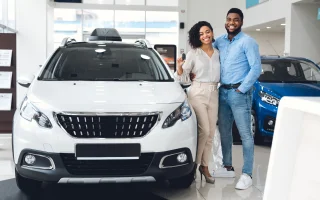Cheap Guaranteed Auto Protection:
Bridge the GAP
GAP Insurance Helps Pay Off Your Totaled or Stolen Vehicle
What is Guaranteed Auto Protection (GAP) Insurance?
GAP is a lifesaver for people whose relatively new vehicle is declared a total loss. It helps protect you financially if your car has depreciated to a value less than what you owe. Many people do not understand how quickly this happens. As soon as you drive your new car off the lot, it begins to lose value rapidly. In fact, many people who finance their vehicle become “upside down” in the first year. This means they owe more than their now used vehicle is worth. If your vehicle is declared a total loss in a covered event, your insurance company will pay you the actual cash value (ACV) — which may be less than what you owe.
This insurance bridges the “gap” between the ACV and what you owe. It is not a required car insurance, but is considered a beneficial coverage add-on. It is only available for newer vehicles less than one year old. If you recently purchased a car, speak to an experienced Acceptance agent to understand GAP insurance.

How Does it Work?
GAP works by paying off your financed loan if your car is declared a total loss, such as what might happen in severe weather. This coverage is only available for new or slightly used cars that are less than a year old. You can cancel it once the amount you owe on your car is less than its market value.
Since your car can depreciate up to 20% in the first year (and more if you drive a lot), the value of your car on the market can be much less than the amount you financed. Here’s an example of how that works and how GAP can step in to save the day:
- Financed amount: $25,000
- ACV after 14 months: $17,500
- Amount you owe: $21,000
- GAP pays: $3,500
The amount of money you owe and what your vehicle is worth are unique factors and depend on your loan terms and how much you drive your vehicle. GAP is certainly something you should explore with your neighborhood insurance agent if you finance a new vehicle.
Types of Auto Insurance Coverage
How Much Does GAP Cost?
The cost is based on your loan and should not be more than 5% of the amount you financed. For example, if you financed $25,000, your GAP add-on should cost roughly $1,250 per year, or $104 monthly. You may be able to find it at 3%, depending on your driving record, claims history and other factors unique to you.
Be wary of accepting insurance from your dealership, as it is often more expensive all around than shopping on your own — or with the help of a friendly independent agent.
Ready to Get a Quick Quote?
What Does GAP Insurance Cover?
It kicks in when your vehicle is declared a total loss in a covered event. It is used with full coverage, which includes comprehensive insurance and collision coverage. When your vehicle is totaled in a wreck or other covered event, such as a fire, or it is stolen, your comprehensive or collision kicks in to pay the actual cash value of your depreciated vehicle (you can estimate this amount at Kelly Blue Book). Your GAP will pay the difference between that amount and what you still owe.
Another similar, but different, type of add-on coverage is new car replacement coverage. Both are designed to help you financially if your vehicle is totaled or stolen. However, GAP pays off your loan, while new car replacement puts you in a new car of the same make and model (or something very similar).
Should I Purchase GAP Coverage?
Purchasing add-on coverages is dependent on your unique situation. In the case of GAP, your loan terms and how much you plan to use your vehicle are all considerations. Here are some reasons why it might be a good idea for you:
- Your vehicle is new and is financed or leased.
- Calculate your annual payments to see if your loan amount will drop significantly or not so much in the first years of ownership. If your payments are small, your interest rate is high and you did not have a good-sized down payment, it is worth considering.
- You would have trouble coming up with the loan balance in the event of a total loss. Nobody wants to continue making payments on a vehicle they no longer own.
- You will be driving more than the normal amount (more than 13,000-14,000 miles per year). Mileage accelerates depreciation, so your vehicle may not command as much on the market if you’ve put a lot miles on the odometer.
If you choose to purchase this type of coverage, you can cancel it once your loan balance is equal to or less than the value of your car. However, if you own the vehicle outright, GAP coverage is not necessary.

What Does it Not Cover?
GAP only kicks in when your car is a total loss, whether through storm damage, a fire, vandalism or theft. It does not apply to repairs, a down payment for a new vehicle, rental car reimbursement or any other assorted fees associated with your situation. Your claim may be denied if you are behind on your payments or you do not have the correct documentation, including:
- Insurance settlement statement: This statement shows the ACV and the amount of the settlement check.
- Loan/lease documents: Your original contract, sales agreement and history of payments.
- Police report: An official police report made at the time of the car’s loss.
Buying your coverage from the same insurer helps facilitate the gathering of some of these documents. Ask your friendly Acceptance agent for information.
After I File a Claim, Can I Stop Making Car Payments?
It is not recommended to stop paying your car payments following a claim. Your lender still expects your monthly payments even if your car is no longer available to drive. When your claim is approved, you can recoup the payments you’ve made. If you do not pay, your lender may report you to the credit bureaus, which can have a negative impact on your credit score.
What is the Difference Between GAP and Full Auto Coverage?
If you are financing your vehicle, you’ll be required to carry full coverage (liability plus comprehensive and collision). GAP is normally a voluntary part of your policy and works in tandem with your full coverage by making up the difference between your car’s value and your loam amount. It’s worth considering if you owe quite a bit on your loan and are not making large enough monthly payments to significantly decrease the principal loan amount.
Get Affordable GAP Insurance Coverage Today
If you’ve purchased a new vehicle you should consider GAP. Our experienced and friendly agents can help you weigh the pros and cons when it comes to necessary coverages and your budget. We do the work for you — shopping around with major carriers to make sure you have options. At Acceptance, we welcome your questions. Reach out for a free car insurance quote online, give us a call at 877-405-7102 or stop by one of our convenient locations
